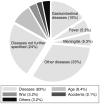Dynamics of socioeconomic risk factors for neglected tropical diseases and malaria in an armed conflict
- PMID: 19907632
- PMCID: PMC2731884
- DOI: 10.1371/journal.pntd.0000513
Dynamics of socioeconomic risk factors for neglected tropical diseases and malaria in an armed conflict
Abstract
Background: Armed conflict and war are among the leading causes of disability and premature death, and there is a growing share of civilians killed or injured during armed conflicts. A major part of the civilian suffering stems from indirect effects or collateral impact such as changing risk profiles for infectious diseases. We focused on rural communities in the western part of Côte d'Ivoire, where fighting took place during the Ivorian civil war in 2002/2003, and assessed the dynamics of socioeconomic risk factors for neglected tropical diseases (NTDs) and malaria.
Methodology: The same standardized and pre-tested questionnaires were administered to the heads of 182 randomly selected households in 25 villages in the region of Man, western Côte d'Ivoire, shortly before and after the 2002/2003 armed conflict.
Principal findings: There was no difference in crowding as measured by the number of individuals per sleeping room, but the inadequate sanitation infrastructure prior to the conflict further worsened, and the availability and use of protective measures against mosquito bites and accessibility to health care infrastructure deteriorated. Although the direct causal chain between these findings and the conflict are incomplete, partially explained by the very nature of working in conflict areas, the timing and procedures of the survey, other sources and anecdotal evidence point toward a relationship between an increased risk of suffering from NTDs and malaria and armed conflict.
Conclusion: New research is needed to deepen our understanding of the often diffuse and neglected indirect effects of armed conflict and war, which may be worse than the more obvious, direct effects.
Conflict of interest statement
The authors have declared that no competing interests exist.
Figures




Similar articles
-
Effect of an armed conflict on relative socioeconomic position of rural households: case study from western Côte d'Ivoire.Emerg Themes Epidemiol. 2010 Aug 31;7(1):6. doi: 10.1186/1742-7622-7-6. Emerg Themes Epidemiol. 2010. PMID: 20807398 Free PMC article.
-
Men's and women's experiences of violence and traumatic events in rural Cote d'Ivoire before, during and after a period of armed conflict.BMJ Open. 2014 Feb 25;4(2):e003644. doi: 10.1136/bmjopen-2013-003644. BMJ Open. 2014. PMID: 24568959 Free PMC article.
-
[Malaria transmission in lagoon areas in Côte d'Ivoire: the villages of N'gatty and Allaba].Sante. 2010 Apr-Jun;20(2):73-9. doi: 10.1684/san.2010.0183. Epub 2010 Aug 5. Sante. 2010. PMID: 20685640 French.
-
Preventing gender-based violence engendered by conflict: The case of Côte d'Ivoire.Soc Sci Med. 2015 Dec;146:341-7. doi: 10.1016/j.socscimed.2015.10.009. Epub 2015 Oct 14. Soc Sci Med. 2015. PMID: 26482357 Review.
-
Child mortality following armed conflict: how long does it take to reduce to pre-conflict level?BMJ Paediatr Open. 2025 Apr 24;9(1):e003379. doi: 10.1136/bmjpo-2025-003379. BMJ Paediatr Open. 2025. PMID: 40280563 Free PMC article. Review.
Cited by
-
Inequalities in the social determinants of health and Chagas disease transmission risk in indigenous and creole households in the Argentine Chaco.Parasit Vectors. 2019 Apr 27;12(1):184. doi: 10.1186/s13071-019-3444-5. Parasit Vectors. 2019. PMID: 31029147 Free PMC article.
-
Micro-encapsulated pirimiphos-methyl shows high insecticidal efficacy and long residual activity against pyrethroid-resistant malaria vectors in central Côte d'Ivoire.Malar J. 2014 Aug 25;13:332. doi: 10.1186/1475-2875-13-332. Malar J. 2014. PMID: 25152326 Free PMC article.
-
Spatial spillovers of violent conflict amplify the impacts of climate variability on malaria risk in sub-Saharan Africa.Proc Natl Acad Sci U S A. 2024 Apr 9;121(15):e2309087121. doi: 10.1073/pnas.2309087121. Epub 2024 Apr 1. Proc Natl Acad Sci U S A. 2024. PMID: 38557184 Free PMC article.
-
Analysing the six-year malaria trends at Metehara Health Centre in Central Ethiopia: the impact of resurgence on the 2030 elimination goals.Malar J. 2024 Jan 23;23(1):32. doi: 10.1186/s12936-024-04854-w. Malar J. 2024. PMID: 38263087 Free PMC article.
-
A geostatistical analysis of the association between armed conflicts and Plasmodium falciparum malaria in Africa, 1997-2010.Malar J. 2015 Dec 16;14:500. doi: 10.1186/s12936-015-1024-5. Malar J. 2015. PMID: 26670739 Free PMC article.
References
-
- Foege WH. Arms and public health: a global perspective. In: Levy BS, Sidel VW, editors. War and Public Health. Washington DC: American Public Health Association; 2000. pp. 3–11.
-
- Murray CJL, Lopez AD. The Global Burden of Disease. A Comprehensive Assessment of Mortality and Disability from Diseases, Injuries, and Risk Factors in 1990 and Projected to 2020. Geneva: World Health Organization; 1996. pp. 1–990.
-
- WHO. The World Health Report 2004: Changing History. Geneva: World Health Organization; 2004. pp. 1–169.
Publication types
MeSH terms
LinkOut - more resources
Full Text Sources
Medical

